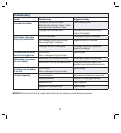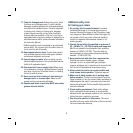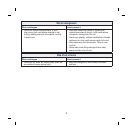
5
17. Check for damaged parts. Before using a tool, check
that there are no damaged parts. If a part is slightly
damaged, carefully determine if it will operate properly
and perform its intended function. Check for alignment
of moving parts, binding of moving parts, breakage
of parts, proper mounting and any other conditions
that may affect the operation of the tool. A part that is
damaged should be properly repaired or replaced by an
authorised service facility, unless otherwise indicated in
this Instruction Manual.
Defective switches must be replaced by an authorised
service facility. Do not use a tool if the switch does not
turn the tool on and off correctly.
18. Guard against electric shock. Prevent body contact
with grounded objects such as water pipes, radiators,
cookers and refrigerator enclosures.
19. Use only approved parts. When servicing, use only
identical replacement parts. Use an authorised service
facility to fit replacement parts.
20. Disconnect tool from air supply hose. Before doing
tool maintenance, clearing a jammed fastener, leaving
work area, moving tool to another location, or handing
the tool to another person.
21. Never use a tool that is leaking air, has missing or
damaged parts, or requires repair. Make sure all
screws and caps are securely tightened.
22. Operator and others in work area MUST wear safety
glasses with side shields.
Additional safety rules
for framing gun nailers
1. Do not play with the contact element. It prevents
accidental discharge, so it must be kept on and not
removed. Securing the trigger in the ON position is also
very dangerous. Never attempt to fasten the trigger. Do
not operate a tool if any portion of the tool operating
controls is inoperable, disconnected, altered, or not
working properly.
2. Operate the tool within the specified air pressure of
0.5 - 0.8 MPa (75 – 120 PSI) for safety and longer tool
life. Do not exceed the recommended max. operating
pressure of 0.8 MPa (120 PSI). The tool should not
be connected to a source whose pressure potentially
exceeds 1.37 MPa (200 PSI).
3. Never use the tool with other than compressed air.
If bottled gas (carbon dioxide, oxygen, nitrogen,
hydrogen, air, etc.) or combustible gas (hydrogen,
propane, acetylene, etc.) is used as an air source for this
tool, the tool will explode and cause serious injury.
4. Always check the tool for its overall condition and
loose screws before operation. Tighten as required.
5. Make sure all safety systems are in working order
before operation. The tool must not operate if only the
trigger is pulled or if only the contact safety mechanism is
pressed against the wood. It must work only when both
actions are performed. Test for possible faulty operation
with nails unloaded.
6. Check working environment. Check walls, ceilings,
floors, roofing and the like carefully to avoid possible
electrical shock, gas leakage, explosions, etc. caused by
striking live wires, conduits or gas pipes.
7. Use only nails specified in this manual. The use of
any other nails may cause malfunction of the tool and will
not be covered under warranty.


















